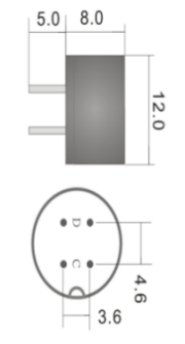
The DSC01-G50K-SG catalytic combustion gas sensor operates based on the principle of catalytic combustion. It consists of a sensing element and a compensating element paired as one arm of a bridge. When combustible gases are encountered, the resistance of the sensing element increases, resulting in a change in the bridge output voltage. This voltage change is directly proportional to the gas concentration, with the compensating element serving as a reference and providing temperature and humidity compensation.
Features
* High stability
* Excellent resistance to poisoning
* Fast response and recovery time
* Not affected by orientation
* High linearity
Applications
* Residential/commercial gas leak detection
* Portable gas detectors
Dimensions
Figure 1: Sensor Structure Diagram

Main Technical Specifications
Product Model: | DSC01-G50K-SG |
Gas Detection: | Most combustible gases or vapors. |
Operating Voltage: | DC 2.5 ± 0.15V |
Operating Current: | DC 180~190mA |
Detection Range: | 0~100%LEL |
Detection Accuracy: | ±1%LEL |
Sensitivity: | >12mV/% Methane. |
Zero Drift: | <±5% LEL (Lower Explosive Limit) for methane per year. |
Response Time: | T90<15s |
Recovery Time: | <20s |
Operating Environment: | -40~+70℃ (Non-condensing) Continuous: 15~90% RH Intermittent: 0~99% RH |
Storage Environment: | -20~+50℃ Below 95% relative humidity (RH) (non-condensing). |
Lifespan: | 5 years (in clean air). |
